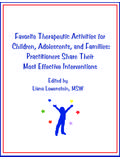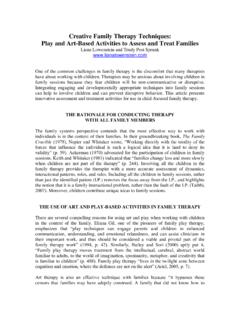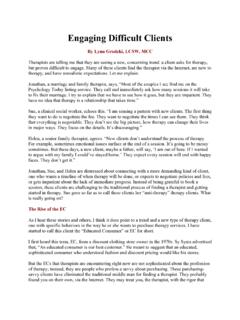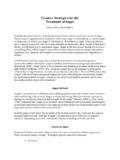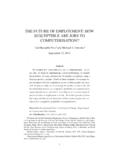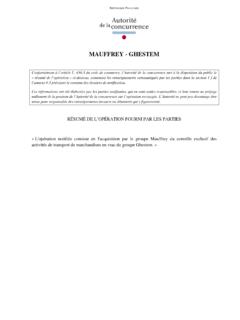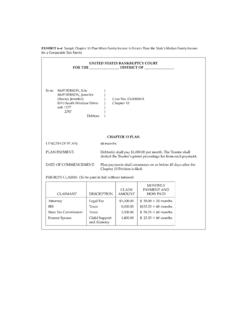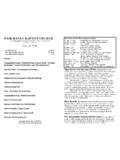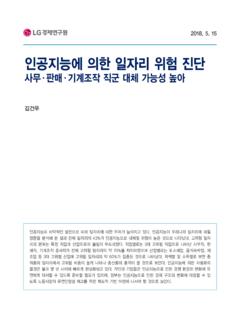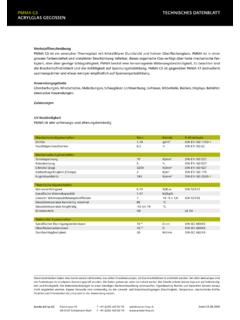Transcription of Creative Strategies for the Treatment of Anger
1 Creative Strategies for the Treatment of Anger Diane E Frey, , RPT S Probably the most common underlying emotion many clients experience is one of Anger . Clients may be oppositional or defiant, in which case Anger is externalized, or clients might be depressed, in which case Anger is internalized. Nevertheless, Anger related problems are a common reason for referral to mental health professionals. Most people, if they had a choice, would prefer not to experience Anger . Anger is the mood most people are worse at controlling (Tice, 1993). Anger is one of the six basic human emotions along with sadness, happiness, fear, surprise, and disgust. It is an emotion that all humans feel, regardless of culture. Of all human emotions, Anger has created the most harm and caused the greatest destruction within individuals, couples, families, and between social groups and nations (Borcherdt, 1989). Anger can be a very powerful and dangerous emotion.
2 In his book Anger Kills, Redford Williams (1993) cites the impact Anger has on the immune system and its relationship to hypertension, coronary artery disease, and cancer. Barris (1999) states that Anger is the most important psychological problem confronting the world today, despite the universal problem of Anger , it remains one of the least studied emotions and is even less understood in terms of its Treatment . Anger Defined Anger is an emotion, an affective state of feeling experienced when needs are frustrated or when well being is threatened. Anger is emotional energy that can motivate a person to attempt to remedy the situation that brought on the Anger (Marion, 1994, p. 156). Tarvis (1989) indicated that Anger is an emotion that is temporary and it combines physiological arousal and emotional arousal. It can range in severity all the way from intense rage to cool Anger that doesn't really involve arousal at all. Healthy Anger occurs when the intensity of the feeling matches the event and the Anger is managed appropriately.
3 Feelings of Anger can generate positive behavior or negative behavior, depending upon each individual's manner of dealing with this emotion. Causes of Anger Benjamin Franklin once said, Anger is never without a reason but seldom a good one. There are many causes of Anger biological, genetic, and environmental. Stressors Stressors such as interpersonal and intrapersonal conflicts can lead to situational Anger . Such stressors in school aged children could be parental pressure, conflicts with teachers, peer teasing, or academic failures. Overly strict or harsh parenting When parents are overly strict and coercive and use frequent physical punishment, children often develop low self esteem and Anger difficulties. Poor Role Modeling Children learn Anger management from their first role models their parents. If their parents manage Anger inappropriately, children will often imitate the same behavior. Problematic Neighborhoods Children living in tough neighborhoods often have to develop a tough attitude to survive.
4 Hamer (1998) stated that of all the things that determine whether a person will be violent, aggressive, and antisocial, the most important factor is..geography. Analyzed by location, urban children had higher levels of Anger than suburban children. Unresolved Grief Grieving children who do not work though their grief issues can become stuck in the Anger stage of grief. Social Skills Deficits When children lack social skills, they find it difficult to get along with others and they then become frustrated and angry. Learning Disabilities The frustration of not being able to learn in the same way as their peers often results in Anger difficulties. Temperament Some individuals have a temperament that can make them irritable, short fused, and easily frustrated. Hammer (1998) noted that angry people are not solely the product of a bad childhood or neighborhood. Genetic factors constitute 50 per cent of an individual's behavior.
5 Sensory Integration Dysfunction Children with sensory integration problems may overreact to loud noises, bright lights, or the feel of certain clothing. These reactions often lead to Anger . Language Processing Problem When children do not know how to express their feelings, they may become angry and, if they do not know the words to express their Anger , they explode. Mood Disorder Children who are, for example, bipolar, depressed, or anxious may develop Anger outbursts. Attention Deficit Disorder (ADHD) ADHD children often have difficulty maintaining attention, screening out distractions, and regulating motor activity. They can become frustrated or angry. Sexual, Physical, Emotional Abuse Children who have been maltreated are more likely to develop a pattern of aggression and inappropriate behavior. Assessment of Anger The following is a summary of problematic Anger : It is too frequent. It is too intense. It lasts too long.
6 It masks other feelings. It disturbs family and/or work relationships. It begins a destructive cycle that often cannot be controlled. It hurts people. A comprehensive assessment of Anger explores the above areas. Another way to assess Anger is with the Children's Inventory of Anger Game (Western Psychological Services). This inventory is appropriate for ages 6 to 16. This self report inventory can be hand scored in four minutes, providing the evaluator with a profile of the child's' Anger . Children's drawings as well as non directive play can reveal patterns of intrapunitive and/or extrapunitive Anger . Self rating scales that ask clients to rate themselves from 1 to 10 on how they experience Anger in various situations in their lives or at various times during the therapy session can be helpful. This process not only helps the mental health professional assess levels of Anger in the client but also helps the client become more aware of Anger triggers.
7 Rationale for Using Play Therapy in Anger Management Many clients with Anger management concerns are resistant to Treatment . Many are sent by court referrals or come even though they do not believe they need therapy. Many clients with Anger concerns have an attributional bias in that they believe their Anger issues are caused by others. Therefore they believe the others need Treatment . Consequently, traditional talk therapy is ineffective. Many clients with Anger issues are in denial. They do not believe they have an Anger management problem. If this belief system persists, it is difficult to use traditional talk therapy with them. For clients who are verbally deficient, talk therapy is insufficient. Such clients might have intellectual disabilities, selective mutism, or autism spectrum disorders. The symbolism of play therapy can be very helpful to them. Clients might be proficient at talking about some concerns but, when it comes to discussing Anger , they find it very difficult to talk.
8 Play therapy helps them to express the feeling of Anger symbolically. Play Therapy Strategies for the Treatment of Anger Kagan (1998) noted that the brains of 9 million people are like a million different cans of tomato soup, each having a slightly different combination of rosemary, pepper, salt, and thyme. As such, each Treatment plan needs to be individualized to each client, taking into consideration the particular Anger dynamic presented, evidence based approaches, environment of the client, skills of the therapist, and learning modalities of the client. One of the most effective ways to help clients with Anger related Treatment issues is to use the 3 Cs of coaching, cheerleading, and counseling. Coaching gives the client feedback and encouragement. Cheerleading gives the client positive reinforcement. Counseling involves Treatment approaches that provide insight development and coping skills. Creative techniques for treating Anger difficulties in children are presented below.
9 Anger Fortune Cookies: In this technique the therapist can prepare fortune cookies and insert various quotations about Anger that are appropriate for the age of the clients. Some examples might be: Anger is only one letter short of danger. For every minute you're angry, you lose sixty seconds of happiness. Speak when you are angry and you will make the best speech you will ever regret. Clients open the fortune cookies and discuss how that quote might apply to them. Clients can be coached to replace negative self talk with the positive messages from the fortune cookies. The clients can then eat the fortune cookies. Fist Friends: This is a hand puppet technique in which the client is asked to draw a face on his/her hand in the area where the thumb and first finger meet. When the thumb is tucked under the first finger a mouth can be formed by moving the thumb up and down. The client is asked to draw an angry face on one hand and a calm face on the other.
10 Ask the fist friends to talk to each other. For example, the angry first friend might say, It's not my fault I hit him. The calm fist could help the angry fist by saying, Maybe next time try calming down before you do anything. The Angry Box: The client is asked to write an angry word or symbol on the outside of the box. The therapist puts sentence stems pertaining to Anger in the box. The therapists and client take turns picking sentence stems from the box and completing the sentences. Examples of sentence stems include: I get angry every time I___. When I tell someone I'm angry, I feel___. Some ways to get my Anger out without hurting anyone are____. Through this activity the therapist and client can discuss self talk statements. The Un Mad Song: Music can be an effective distraction technique. Clients can listen to music, which captures their attention and can help to calm them down. The un . mad song can be helpful in generating ideas for distractions.
